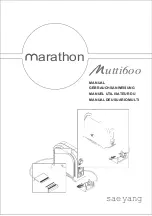
Usage Guidelines
Follow these instructions in order to confirm that you have the correct settings. When you lie down with both arms
across your chest the Inversion Table should rotate a few inches UPWARD. If the Inversion Table does not move or if it
tilts all the way back, the settings are incorrect.
As you lift ONE arm upwards over your head, the Inversion Table will continue to rotate further back. To get back up,
bring your arm back to your side. You can increase the angle and speed of rotation by using both arms.
If you have trouble getting back up, bend your knees and slide your bottom down towards your feet. If the Inversion
Table is in the full 90 degree inversion position, grab both sides of the Inversion Table and pull forward. DO NOT TRY
TO GET UP BY LIFTING YOUR HEAD.
START SLOWLY!
We recommend for the first time to invert only to 20 or 30 degrees. Spend no more than 5 minutes at any one time in an
inverted position. We recommend inverting for just a few minutes each time for the first several weeks
LISTEN TO YOUR OWN BODY!
If you show signs of overdoing it such as headaches, dizziness, flushed face or any discomfort in the ankles, knees or
hips, STOP IMMEDIATELY.
ANGLES OF INVERSION
Beginners should start at 20 to 30 degrees. This will provide mild stretching and allow your body to
get used to being upside down.
Once you feel comfortable, adjust the angle to 50 or 60 degrees. This allows full decompression of the spine. It is not
necessary or required for you to invert at more than 60 degrees.
For maximum stretching, invert to 90 degrees.
OSCILLATION
Raise and lower your arms slowly, back and forth. This will rotate your body backwards (raised arms)
and bring you back up (lowered arms).
Getting used to being upside down can take some time. Start out with just a few minutes each day.
After your body is used to being upside down, feel free to invert two or three times a day.






























